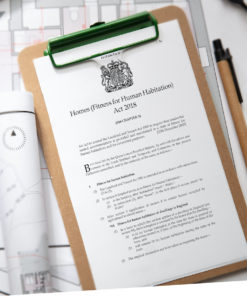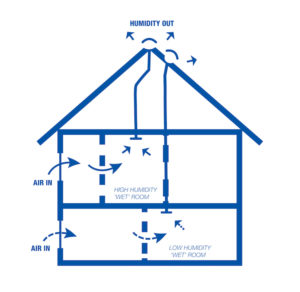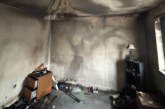Damp, condensation and mould can be perennial challenges in social housing. The associated risks to occupants’ health are well documented. Eliminating the problem clearly pays dividends in terms of happy, healthy tenants. But reduced maintenance costs, avoiding expensive structural repairs and maintaining property values are also good reasons to seek the best ventilation solution. Michelle Wareing, Technical Product Manager at Glidevale Protect, looks at some of the ways this can be achieved effectively and economically.
The issues
Everyday activities such as cooking, washing, drying and even breathing all add to water vapour levels in the home. The volumes can be surprisingly high — research shows that a typical family of four produces up to 14 litres of moisture a day.
Some of this moisture is ventilated to the atmosphere, but some is absorbed by the structure itself through interior surfaces, and a significant proportion ends up in loft spaces, where it can cause condensation build up.
One of the biggest problems of persistent moisture is that it encourages the growth of mould on walls and other surfaces. This produces fungal spores, which spread through the air and can be particularly dangerous for people with respiratory conditions such as asthma.
The scale of the problem was brought to light in 2018 by a survey* of 88 local authorities managing a combined total of almost 475,000 homes. This revealed over 57,000 individual complaints relating to condensation, mould and damp had been received from residents over a six-year period — a total complaint rate of 12.2%.
Such complaints are by no means limited to cold, poorly maintained stock, as is often assumed to be the case. Mould growth can occur at any temperature between 5˚C and 40˚C. Indeed, one local authority surveyed reported that, despite installing a mix of cavity and external wall insulation in all its stock, it still received complaints from 80% of its residents.
Whatever the temperature, the most critical factor for the development of condensation and mould is a relative humidity of 65% or above, and the single most effective way to manage humidity levels and reduce the risk remains natural ventilation.
 The legislation
The legislation
The Homes (Fitness for Human Habitation) Act 2018
All new tenancies in the private and public sector, originating on or after 20th March 2019 must comply with this Act’s provisions. Tenancies started before 20th March 2019, are also liable to comply with the Act as of the 20th March 2020. Among the Act’s provisions are the legal obligations to provide freedom from damp and adequate ventilation in rented properties. As the landlord, you must ensure that all damp and ventilation issues are fully resolved, via solutions that comply with the relevant Building Regulations.
It should also be remembered that this new Homes Act update is likely to lead to increased claims from tenants against landlords renting non-compliant properties.
In the roof space
Often mistaken for roof leaks, ceiling mould and stains are mostly caused by harmful roof space condensation. Furthermore, whilst increased insulation within the roof improves energy efficiency, it is important to consider eradicating roof space condensation via proper ventilation methods.
The best solution is to install purpose-designed slate or tile ventilators with an integral throat or purpose designed extension sleeve to ensure the opening is sleeved for the depth of the roof, to meet the design requirement of BS 5250. Correctly installed slate or tile ventilators will remain weatherproof and fit for function for the life of the building — simply fit and forget. They can be easily installed as part of the normal slating or tiling process or retrofitted.
It’s worth noting roof void condensation can often go undetected over long periods, therefore it is advisable to schedule inspections in your housing stock before mould and rot takes hold and causes potentially dangerous (and certainly expensive) structural problems.
 In the living space
In the living space
Excess moisture in living areas, kitchens, bedrooms and bathrooms can be tackled in a variety of different ways. Providing air inlets to dry habitable rooms and ensuring extract systems are installed in wet rooms, is an easy method of ensuring housing stock has adequate ventilation levels when fitting retrospectively.
Passive ventilation systems will last the planned life of a dwelling (source: Energy Saving Trust and BBA). This is because there are no electrical components requiring maintenance and replacement. With other ventilation systems, electrical fans are used, which have finite motor lives and will require periodic replacement. Replacements cost money. Even better, inlets and extracts that automatically open and close depending on humidity levels in the room, slows down the extract and inlet rate when not required, thereby saving energy.
Long-term trusted partners
Glidevale Protect has worked closely with UK local authorities, housing associations and contractors over many years, often on housing stock refurbishments. We know ventilation and its associated legislation inside out, which is why we are regularly relied on for site surveys, specifications and installation best practice advice. We take pride in our right-first-time reputation, and we are always on hand to help.
Partnering with our technical team gets you straight to the answer, quickly and efficiently. The team can help save valuable time and resources for property maintenance managers involved in energy upgrade schemes.
* CIT (Consultancy, Investigation, Training) Freedom of Information Act request.
The header image shows Glidevale Protect tile ventilators in situ.









